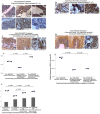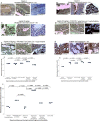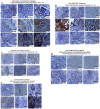Prognostic significance of BIRC7/Livin, Bcl-2, p53, Annexin V, PD-L1, DARC, MSH2 and PMS2 in colorectal cancer treated with FOLFOX chemotherapy with or without aspirin
- PMID: 33465114
- PMCID: PMC7815153
- DOI: 10.1371/journal.pone.0245581
Prognostic significance of BIRC7/Livin, Bcl-2, p53, Annexin V, PD-L1, DARC, MSH2 and PMS2 in colorectal cancer treated with FOLFOX chemotherapy with or without aspirin
Abstract
Evasion of apoptosis is associated with treatment resistance and metastasis in colorectal cancer (CRC). Various cellular processes are associated with evasion of apoptosis. These include overexpression of pro-apoptotic proteins (including p53 and PD-L1), anti-apoptotic proteins (BIRC7/Livin and Bcl-2), chemokine receptors (including DARC), and dysregulation of DNA mismatch repair proteins (including MSH2 and PMS2). The aim of this study was to determine the effect of folinic acid, 5-FU and oxaliplatin (FOLFOX) as a single agent and aspirin plus FOLFOX in various combinations on the aforementioned proteins in human CRC, SW480 cell line and rat models of N-Methyl-N-Nitrosourea (NMU)-induced CRC. In addition, effects of the NMU-induced CRC and chemotherapeutic regimens on haematological and biochemical parameters in the rat models were studied. Immunohistochemistry, immunofluorescence and immunoblot techniques were used to study the expression pattern of the related proteins in the human CRC cells pre- and post-treatment. Double contrast barium enema, post-mortem examination and histological analyses were used to confirm tumour growth and the effect of the treatment in vivo in rat models. Notably, we found in human mucinous CRC, a significant increase in expression of the BIRC7/Livin post-FOLFOX treatment compared with pre-treatment (p = 0.0001). This increase provides new insights into the prognostic role of BIRC7/Livin in evasion of apoptosis and facilitation of treatment resistance, local recurrence and metastasis particularly among mucinous CRCs post-FOLFOX chemotherapy. These poor prognostic features in the CRC may be further compounded by the significant suppression of DARC, PD-L1, PMS2 and overexpression of MSH2 and anti-apoptotic Bcl-2 and p53 proteins observed in our study (p < 0.05). Importantly, we found a significant reduction in expression of BIRC7/Livin and reactivation of DARC and PD-L1 with a surge in Annexin V expression in rat models of CRC cells post-treatment with a sequential dose of aspirin plus FOLFOX compared with other treatments in vivo (p <0.05). The mechanistic rational of these effects underscores the importance of expanded concept of possible aspirin combination therapy with FOLFOX sequentially in future CRC management. Validation of our findings through randomized clinical trials of aspirin plus FOLFOX sequentially in patients with CRC is therefore warranted.
Conflict of interest statement
The authors have declared that no competing interests exist.
Figures









Similar articles
-
Two nanoformulations induce reactive oxygen species and immunogenetic cell death for synergistic chemo-immunotherapy eradicating colorectal cancer and hepatocellular carcinoma.Mol Cancer. 2021 Jan 6;20(1):10. doi: 10.1186/s12943-020-01297-0. Mol Cancer. 2021. PMID: 33407548 Free PMC article.
-
Mismatch repair protein expression is an independent prognostic factor in sporadic colorectal cancer.Acta Oncol. 2010 Aug;49(6):797-804. doi: 10.3109/02841861003705786. Acta Oncol. 2010. PMID: 20307245
-
Prognostic and predictive significance of long interspersed nucleotide element-1 methylation in advanced-stage colorectal cancer.BMC Cancer. 2016 Dec 12;16(1):945. doi: 10.1186/s12885-016-2984-8. BMC Cancer. 2016. PMID: 27955637 Free PMC article.
-
Microsatellite instability testing and its role in the management of colorectal cancer.Curr Treat Options Oncol. 2015 Jul;16(7):30. doi: 10.1007/s11864-015-0348-2. Curr Treat Options Oncol. 2015. PMID: 26031544 Free PMC article. Review.
-
Chemotherapy of metastatic colorectal cancer.Prescrire Int. 2010 Oct;19(109):219-24. Prescrire Int. 2010. PMID: 21180382 Review.
Cited by
-
Resistance to Cell Death in Mucinous Colorectal Cancer-A Review.Cancers (Basel). 2021 Mar 19;13(6):1389. doi: 10.3390/cancers13061389. Cancers (Basel). 2021. PMID: 33808549 Free PMC article. Review.
-
Livin/BIRC7 gene expression as a possible diagnostic biomarker for endometrial hyperplasia and carcinoma.J Genet Eng Biotechnol. 2021 Sep 26;19(1):141. doi: 10.1186/s43141-021-00244-w. J Genet Eng Biotechnol. 2021. PMID: 34568983 Free PMC article.
-
Differential inflammatory conditioning of the bone marrow by acute myeloid leukemia and its impact on progression.Blood Adv. 2024 Oct 8;8(19):4983-4996. doi: 10.1182/bloodadvances.2024012867. Blood Adv. 2024. PMID: 38996202 Free PMC article.
-
The clinicopathological and prognostic significances of IGF-1R and Livin expression in patients with colorectal cancer.BMC Cancer. 2022 Aug 5;22(1):855. doi: 10.1186/s12885-022-09961-y. BMC Cancer. 2022. PMID: 35931997 Free PMC article.
-
Comprehensive analysis of prognostic value and immune infiltration of IAPs family in hepatocellular carcinoma.J Cancer. 2023 Sep 11;14(15):2848-2866. doi: 10.7150/jca.87590. eCollection 2023. J Cancer. 2023. PMID: 37781078 Free PMC article.
References
MeSH terms
Substances
Supplementary concepts
LinkOut - more resources
Full Text Sources
Other Literature Sources
Medical
Research Materials
Miscellaneous

